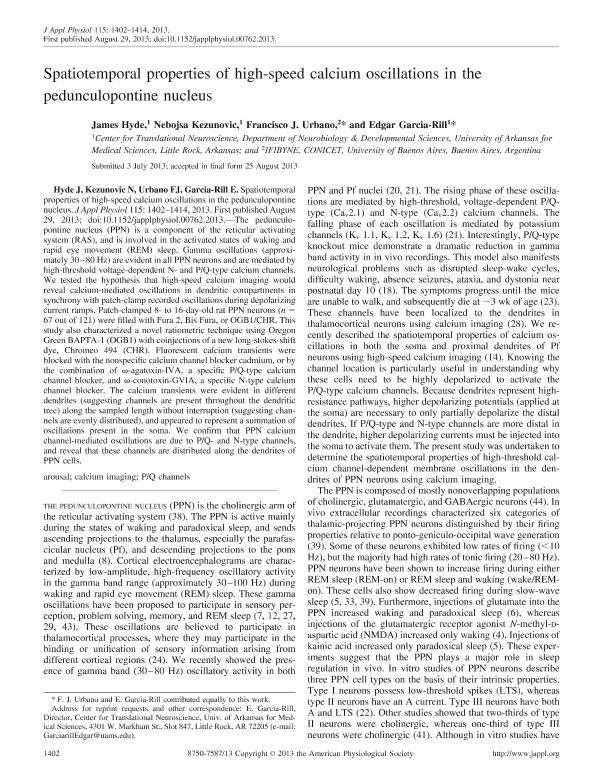Mostrar el registro sencillo del ítem
dc.contributor.author
Hyde, James

dc.contributor.author
Kezunovic, Nebojsa

dc.contributor.author
Urbano Suarez, Francisco Jose

dc.contributor.author
Garcia Rill, Edgar

dc.date.available
2017-07-21T18:18:39Z
dc.date.issued
2013-11
dc.identifier.citation
Hyde, James; Kezunovic, Nebojsa; Urbano Suarez, Francisco Jose; Garcia Rill, Edgar; Spatiotemporal properties of high-speed calcium oscillations in the pedunculopontine nucleus; American Physiological Society; Journal Of Applied Physiology; 115; 9; 11-2013; 1402-1414
dc.identifier.issn
8750-7587
dc.identifier.uri
http://hdl.handle.net/11336/21101
dc.description.abstract
The pedunculopontine nucleus (PPN) is a component of the reticular activating system (RAS), and is involved in the activated states of waking and rapid eye movement (REM) sleep. Gamma oscillations (approximately 30–80 Hz) are evident in all PPN neurons and are mediated by high-threshold voltage-dependent N- and P/Q-type calcium channels. We tested the hypothesis that high-speed calcium imaging would reveal calcium-mediated oscillations in dendritic compartments in synchrony with patch-clamp recorded oscillations during depolarizing current ramps. Patch-clamped 8- to 16-day-old rat PPN neurons (n = 67 out of 121) were filled with Fura 2, Bis Fura, or OGB1/CHR. This study also characterized a novel ratiometric technique using Oregon Green BAPTA-1 (OGB1) with coinjections of a new long-stokes-shift dye, Chromeo 494 (CHR). Fluorescent calcium transients were blocked with the nonspecific calcium channel blocker cadmium, or by the combination of ω-agatoxin-IVA, a specific P/Q-type calcium channel blocker, and ω-conotoxin-GVIA, a specific N-type calcium channel blocker. The calcium transients were evident in different dendrites (suggesting channels are present throughout the dendritic tree) along the sampled length without interruption (suggesting channels are evenly distributed), and appeared to represent a summation of oscillations present in the soma. We confirm that PPN calcium channel-mediated oscillations are due to P/Q- and N-type channels, and reveal that these channels are distributed along the dendrites of PPN cells.
dc.format
application/pdf
dc.language.iso
eng
dc.publisher
American Physiological Society

dc.rights
info:eu-repo/semantics/openAccess
dc.rights.uri
https://creativecommons.org/licenses/by-nc-sa/2.5/ar/
dc.subject
Arousal
dc.subject
Pedunculopontine
dc.subject
Calcium Imaging
dc.subject
P/Q Type Calcium Channels
dc.subject.classification
Neurociencias

dc.subject.classification
Medicina Básica

dc.subject.classification
CIENCIAS MÉDICAS Y DE LA SALUD

dc.title
Spatiotemporal properties of high-speed calcium oscillations in the pedunculopontine nucleus
dc.type
info:eu-repo/semantics/article
dc.type
info:ar-repo/semantics/artículo
dc.type
info:eu-repo/semantics/publishedVersion
dc.date.updated
2017-07-11T13:25:06Z
dc.identifier.eissn
1522-1601
dc.journal.volume
115
dc.journal.number
9
dc.journal.pagination
1402-1414
dc.journal.pais
Estados Unidos

dc.description.fil
Fil: Hyde, James. University Of Arkansas For Medical Sciences; Estados Unidos
dc.description.fil
Fil: Kezunovic, Nebojsa. University Of Arkansas For Medical Sciences; Estados Unidos
dc.description.fil
Fil: Urbano Suarez, Francisco Jose. Consejo Nacional de Investigaciones Científicas y Técnicas. Oficina de Coordinación Administrativa Ciudad Universitaria. Instituto de Fisiología, Biología Molecular y Neurociencias. Universidad de Buenos Aires. Facultad de Ciencias Exactas y Naturales. Instituto de Fisiología, Biología Molecular y Neurociencias; Argentina
dc.description.fil
Fil: Garcia Rill, Edgar. University Of Arkansas For Medical Sciences; Estados Unidos
dc.journal.title
Journal Of Applied Physiology

dc.relation.alternativeid
info:eu-repo/semantics/altIdentifier/doi/http://dx.doi.org/10.1152/japplphysiol.00762.2013
dc.relation.alternativeid
info:eu-repo/semantics/altIdentifier/url/http://jap.physiology.org/content/115/9/1402
Archivos asociados
